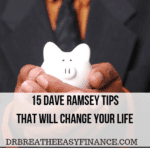If you are going to read two personal finance books with two contrasting, yet complementary lessons and principles, it has to be the rich dad poor dad by Robert Kiyosaki and total money makeover by Dave Ramsey.
We have talked a lot about Dave Ramsey on this blog including 15 Dave Ramsey tips that will change your life. We also gave a counterpoint to the 7 baby steps with our own 12 Toddler steps to financial freedom.
This is not the first book we would review from Robert Kiyosaki either, we wrote an epic summary and review of the cash flow quadrant. You might want to bookmark that summary for later, it ties in nicely with the current article – rich dad poor dad review summary.
As a young boy, Robert Kiyosaki grew up with two very influential people. One was his biological father, and another he called his second father.
He refers to his real father as the poor dad based on his dad ideologies. The typical parents, especially from my African background want you to go to school, get straight As, become a doctor and work for money.
He refers to his friend’s dad- aka second dad as the rich dad. This was also based on his ideologies that having a good financial knowledge and starting a business is the most important secret to wealth.
He learned great financial lessons from each father, which created the foundation of knowledge he needed to build a multi-million dollar empire.
Rich Dad Poor Dad is about the lessons Robert Kiyosaki learned from each of his influential father figures, and why they matter today about money and building wealth. In it, you will learn why “go to school, get your degree, and find a good job” no longer works the way it used to in order to build wealth and retire with a healthy nest egg, or even retire early.
you will learn why “go to school, get your degree, and find a good job” no longer works the way it used to in order to build wealth Share on X

Table of Contents
6 Lessons On How To Build Wealth
In Rich Dad Poor Dad, Robert Kiyosaki gives firsthand personal experiences and explanations of the 6 main lessons he learned from his “Rich Dad” on how to build wealth. He compares them to the way his “Poor Dad” viewed money, and how “the old way” of “go to school, get your degree, and find a good job” just won’t suffice for those looking to build wealth.
Lesson #1 – The Rich Don’t Work For Money
If the rich don’t work for money, then how are they rich? Seems like a backward statement, but in reality, it’s spot on and a major reason why many families and individuals fail to build a retirement nest egg. So what exactly does this mean?
The rich don’t work for money, because they make their money work for them. In other words, they purchase income-producing assets with their money that can generate a consistent stream of income indefinitely. These assets may be real estate, buying up small businesses, investing their money in growing companies, and everything in between.
If your money is hard at work making more money, your need for a job is eliminated because you can live off the earnings your money makes for you. Thus the title of the first lesson taught in Rich Dad Poor Dad – “The Rich Don’t Work For Money.”
This particular concept was reinforced in our first book review – The richest man in Babylon. Think of your money as slaves, they work for you.
Thus the title of the first lesson taught in Rich Dad Poor Dad - “The Rich Don’t Work For Money.” Share on X
Lesson #2 – Why Teach Financial Literacy
Many believe if they can just save enough money, or win the lottery, or something of the likes, that they will solve all their stress and problems. The reality is, money will not solve their problems, and will soon be gone as Robert teaches in Lesson 2. In his own words “Intelligence solves problems and produces money. Money without financial intelligence is money soon gone.”
The need for sound financial literacy has never been stronger than it is now. The basic concepts of how money works, and why it’s important to keep a portion of everything you earn, and then turn around and make that money work for you, are surprisingly unknown to most people.
You can start teaching your children financial literacy like his second dad right now so that your children can launch successfully into financial adulthood. The article discussed 8 steps to free your children that failed to launch and how to prevent this from ever happening to your children.
Lesson #3 – Mind Your Own Business
Keith Cunningham was a close friend of Robert Kiyosaki’s and told him of an experience he had at the University of Texas. Keith was part of an MBA class that had the opportunity to listen to Ray Kroc, the owner of McDonalds.
Ray Kroc met with the student’s afterword for a drink in which Ray asked the students “What business am I in?” The students chuckled at his question, to which he asked again “What business do you think I am in?” One of the students responded that he is in the business of making hamburgers.
Ray responded saying he knew that they’d have that response, to which Ray Kroc corrected them and said “…I’m not in the hamburger business, my business is real estate.”
Ray then went on to say that his whole focus of the McDonalds franchises was to locate the most potential geographical locations to place the McDonalds franchises. Today he owns more real estate than anyone in the world at some of the busiest intersections.
The lesson: working for someone else your entire life is often the direct result of the current financial struggle.
Like Ray Kroc, our focus should be on building businesses and assets that produce indefinite income streams resulting in choosing whether you want a job or not, since your income is not fixed and it continue to grow.
Lesson #4 – The History of Taxes And The Power of Corporations
Robert’s “Rich Dad” taught him the history of taxes, while his “Poor Dad” had the viewpoint that the rich should pay more taxes to give to the poor. He calls this the “Robin Hood theory of economics”.
This concept is particularly important to understand as the majority of Americans believe in taxing the rich more. You only have to watch the recent democratic debate for yourself to understand how commonplace and rampant this idea is.
Historically, taxes were originally created to help pay for wars and other major events, and soon become a common law by which each citizen was expected to follow.
The idea was so much supported because the poor and middle-class believed that taxing the rich would help the poor, when in the long run the tax burden gave the government an appetite to want more money, resulting in a tax being put on the poor and middle class over time.
Today, the rich are able to use corporations as vehicles to avoid common tax traps and end up paying less in taxes than was originally intended.
This history of taxes caused Robert to understand that the capitalist mindset made more sense because the socialists who wish to impose a larger tax burden ended up hurting themselves due to their lack of financial and economic understanding.
Understanding the history of taxes provides a different mindset on the topic, avoiding the common mistake that imposing a higher tax will ultimately hurt the majority rather than penalize the rich to pay for the poor.
Lesson #5 – The Rich Invest Money
How is one to invest money? Robert gives a personal example of how this can happen. At the time he was living in a down market where housing was running cheaper than usual. He said you could purchase a $100,000 home for $75,000. So he took it even further and began looking at foreclosed homes that banks were selling for even cheaper, sometimes as low as $20,000.
In his experience, he illustrates that he borrowed $2,000 from a friend for a down payment which he would pay back to his friend with $200 for interest. His $20,000 offer on the home was accepted with the down payment. He then processed the purchase of the home, while at the same time started advertising the sale of the same home for $60,000.
Once the home was in his name, he had multiple buyers at the price of $60,000 ready to buy and he then sold that house within minutes at the price of $60,000.
In other words, he took $20,000 and turned it into $60,000, in essence inventing money, as suggests the title of lesson 5.
We recommend reading our famous article on the difference between rich vs wealthy and the 15 habits of highly successful people.
Lesson #6 – Work To Learn – Don’t Work For Money
In this lesson, Robert gives an example of a great writer who went to school and got a degree in writing.
She asked Robert how to be a great writer like he was, and he responded to her mentioning she should try taking a suggested sales course.
The author found this offending since she already had her degree. Robert responded by pointing to his book at the words “best-selling author”. She read it and he said do you see what that says? It says “best-selling…” not “best writing…”.
In other words, she had a degree in writing, but he sold more books and made more money than she did.
The lesson he illustrates with this example is that sometimes all it takes is just learning one more skill in many cases would be just enough to push you over the edge to become the next big success.
You should work to gain more skills so that you can become that “best-selling author”, so that you no longer have to tie yourself to that dreading 9 – 5 job that your degree got you.
The rich are able to work so they can learn more skills allowing them to exponentially accelerate their path to financial well-being and ultimately make money work for you.
Should I Read Rich Dad Poor Dad by Robert Kiyosaki?
Yeah, we all understand the basics of having a bank account, how to balance our checkbook and how a basic car loan works. But do we really understand how monetary economics works? The reality is that money can be used to multiply itself, and build “geese that lay that golden egg” so you no longer have to work by obligation.
he reality is that money can be used to multiply itself, and build “geese that lay that golden egg” so you no longer have to work by obligation. Share on X
If you are seeking to learn how to make money work for you rather than be tied to your traditional 9 – 5 job for 40 years before you “might” retire, then there is no better book to start with than Rich Dad Poor Dad by Robert Kiyosaki.
In it, you will learn the expounded details of each of the 6 lessons mentioned above, with actual real-life experiences that you and I can relate with on a more personal level. After reading this book, your motivation to build wealth will not be a problem, and your drive to apply the lessons taught will be enough to launch you on a prosperous financial path.
You can grab a copy with the link below.
I am a pulmonary and critical care doctor by day and personal finance blogger/debt slaying ninja by night.
After paying off close to $300,000 in student loan debt in less than 6 months into my real job, I started on a mission to help others achieve the same. There is no magic to this than to strap up and get it done. Some of the ways we achieved this include side hustle, budgeting, great negotiation skills, and geographical arbitrage.
When I was growing up, common knowledge in Nigeria is that there is one thing you cannot trust anyone else with, and you guessed it – your money.
Being frugal came easily to me based on my background. However, the concept of building wealth did not solidify in my mind until when I finished medical school. I wish I knew what I know now when I was 14. Still, I don’t know enough and I am constantly learning to improve my knowledge.
My goal is to reduce financial illiteracy among young professionals. I am catering to the beginners – babies and toddlers in financial literacy.








Leave a Reply